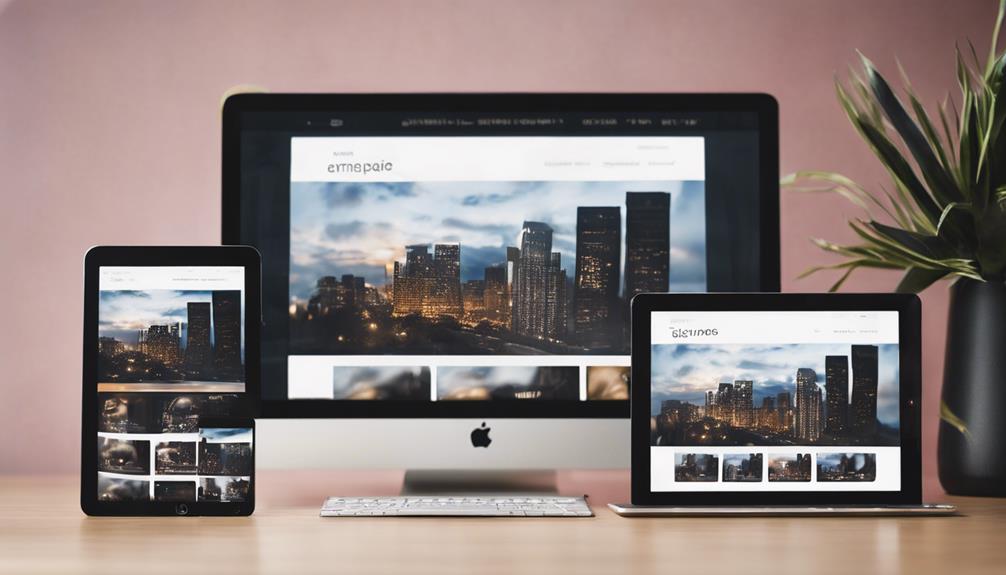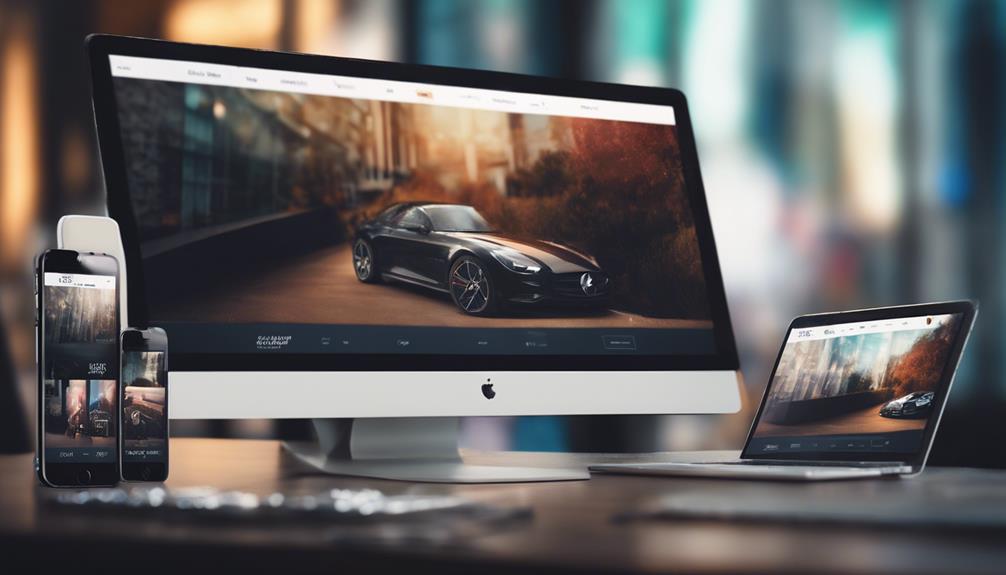In the digital landscape, a remarkable UI web design goes beyond mere aesthetics; it is a harmonious blend of functionality and visual appeal. Elements such as clear navigation, engaging visual hierarchy, and consistent branding play pivotal roles in capturing users' attention.
However, what truly sets a great UI design apart lies in its ability to seamlessly integrate user interaction, adapt to various devices, and prioritize accessibility for all users. These elements form the foundation of a standout UI design, but the real magic happens when they come together in perfect synergy to elevate the user experience to new heights.
Clear and Intuitive Navigation

How can clear and intuitive navigation enhance the user experience of a website?
Clear and intuitive navigation is a foundational element of effective UI web design. When users visit a website, they expect to easily find the information they are looking for. By adhering to web design principles that prioritize clear navigation, designers can guide users seamlessly through the site, leading to a more positive user experience.
Clear and intuitive navigation improves user satisfaction by reducing confusion and frustration. It helps visitors quickly understand the website's structure and find their desired content with minimal effort. Implementing intuitive navigation elements such as a logical menu structure, descriptive labels, and easily accessible search functionality can significantly enhance usability.
Moreover, well-thought-out navigation contributes to the overall user engagement and retention on a website. When users can navigate effortlessly, they are more likely to explore different sections of the site, increasing the time spent on the page and reducing bounce rates. Ultimately, prioritizing clear and intuitive navigation is key to creating a user-friendly website that keeps visitors coming back.
Engaging Visual Hierarchy
The implementation of an engaging visual hierarchy is crucial for capturing users' attention and guiding their focus on key elements within a website. In web design, the visual hierarchy refers to the arrangement of elements in a way that prioritizes their importance. By utilizing engaging visual hierarchy techniques, such as strategic placement, size variation, color contrast, and typography, designers can create a seamless flow that directs users' eyes towards essential information. This not only enhances the overall user experience but also influences user behavior by highlighting specific calls to action or important content.
Creative web design leverages engaging visual hierarchy to ensure that users can easily navigate through the website and find what they are looking for. By carefully structuring the layout and emphasizing key components, designers can create a visually appealing and intuitive interface that keeps users engaged. Ultimately, a well-executed visual hierarchy contributes to a more impactful and memorable user experience, making the website stand out among competitors.
Consistent Branding Elements

When establishing a website's design, maintaining consistent branding elements is essential to reinforce brand identity and create a cohesive user experience. Web design companies, firms, and agencies understand the significance of incorporating consistent branding elements throughout a website. Consistency in elements such as color schemes, typography, logos, and overall design aesthetics helps in building brand recognition and trust among users.
Web design firms often work closely with their clients to ensure that the branding elements align with the company's values, mission, and target audience. By maintaining a uniform look and feel across all web pages, users can easily recognize and associate the website with the brand. This consistency also extends to other marketing materials and platforms, creating a seamless brand experience for customers.
A well-executed design with consistent branding elements not only enhances user engagement but also sets the website apart from competitors. It reinforces the brand's identity and creates a lasting impression on visitors, ultimately leading to increased brand loyalty and recognition.
Seamless User Interaction
Building on the foundation of consistent branding elements, seamless user interaction plays a pivotal role in enhancing the overall user experience on a website. In web design, UX web design focuses on creating interfaces that are intuitive and easy to navigate, ensuring that users can interact with the site effortlessly. Seamless user interaction involves designing elements such as buttons, menus, and forms in a way that guides users through the website smoothly.
To achieve seamless user interaction, designers must prioritize simplicity and clarity in their designs. Clear navigation menus, concise and informative content, and strategically placed call-to-action buttons all contribute to a seamless user experience. By reducing friction points and streamlining the user journey, websites can keep visitors engaged and encourage them to explore further.
Incorporating interactive elements like hover effects, animations, and feedback mechanisms also enhance user engagement and make the website more dynamic. By focusing on seamless user interaction, web designers can create a positive and enjoyable experience for visitors, ultimately leading to higher engagement and conversions.
Responsive and Adaptive Design

An essential aspect of modern web design involves implementing responsive and adaptive design techniques to ensure optimal user experience across various devices. Responsive web design aims to create a seamless viewing experience by adjusting the layout of a website based on the screen size and orientation of the device being used. This ensures that users can easily navigate and interact with the content without having to zoom in or out.
On the other hand, adaptive design involves creating multiple layouts for different screen sizes, allowing the website to adapt to specific device breakpoints.
In the realm of web design and development, incorporating responsive and adaptive design practices is crucial to cater to the diverse range of devices used to access websites today. By focusing on responsive web design principles and incorporating adaptive design strategies, developers can create websites that provide a consistent and user-friendly experience, regardless of the device being utilized. Embracing these techniques not only enhances user satisfaction but also contributes to improved search engine rankings and overall website performance.
Accessibility and Inclusivity Features
To ensure a comprehensive user experience, web designers must prioritize incorporating accessibility and inclusivity features into their designs, complementing the responsive and adaptive techniques previously discussed.
Accessibility and inclusivity features are crucial components of web design that cater to users with disabilities or limitations, ensuring that the website can be navigated and understood by all individuals. Web design tools play a significant role in helping designers implement these features effectively.
Features such as alt text for images, keyboard navigation options, color contrast adjustments, and text resizing capabilities are just a few examples of elements that enhance accessibility and inclusivity.
Web design for creatives should also focus on implementing features that accommodate various user preferences and needs. This includes offering customizable settings for font styles, sizes, and layouts, as well as providing options for language preferences and content translations.
Frequently Asked Questions
How Can User Personas and User Research Help in Creating a Great UI Web Design?
User personas and user research are essential in creating a great UI web design. By understanding the needs, behaviors, and preferences of the target audience, designers can tailor the interface to provide a seamless and intuitive user experience.
What Role Does Color Psychology Play in Creating an Engaging Visual Hierarchy?
Color psychology plays a crucial role in creating an engaging visual hierarchy in design. Understanding how different colors evoke emotions and influence user behavior allows designers to strategically use color to guide users through a website effectively.
How Can a Design System Help Maintain Consistent Branding Elements Across Different Platforms?
A design system is crucial for preserving brand identity coherence across various platforms. It establishes guidelines for typography, color schemes, and layout, ensuring consistency in branding elements. This consistency enhances brand recognition and user experience.
What Are Some Advanced Techniques for Enhancing Seamless User Interaction on a Website?
Advanced techniques for enhancing seamless user interaction on a website involve personalized content based on user behavior, intuitive navigation with clear calls-to-action, interactive elements like animations or microinteractions, performance optimization for quick loading times, and A/B testing for continuous improvement.
How Can Designers Ensure Their Designs Are Accessible to Users With Disabilities and Inclusive of All Individuals?
Designers can ensure inclusivity by following accessibility guidelines like WCAG. Prioritize features like screen reader compatibility, color contrast, keyboard navigation. Conduct user testing with diverse individuals to identify and address any barriers to accessibility, ensuring equal access for all users.

